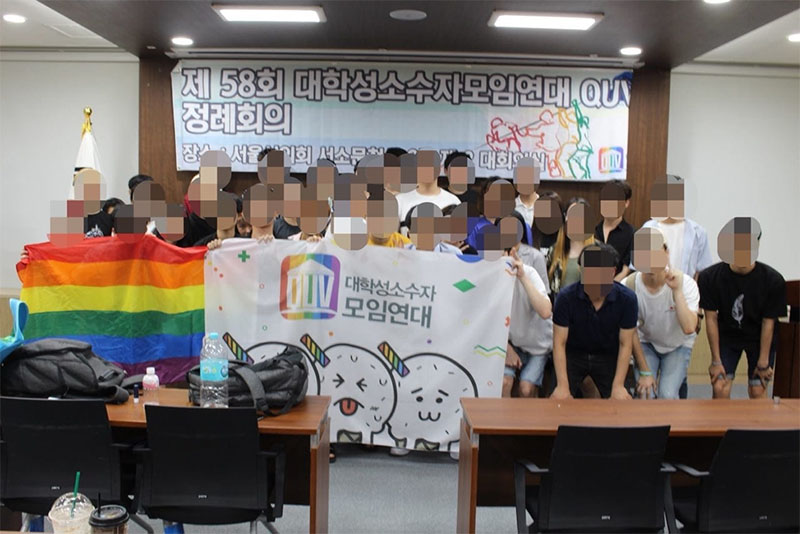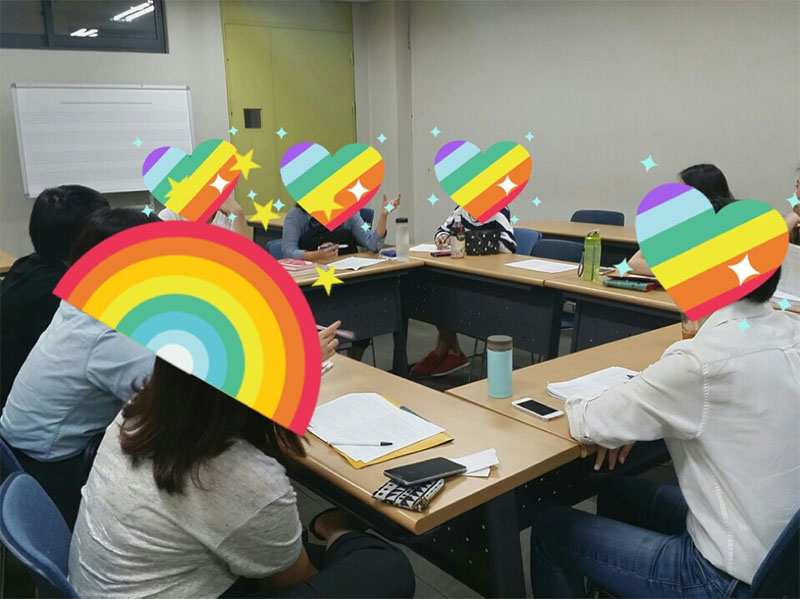When is a face not a face? With the launch of the iPhone X that boasts facial recognition capabilities, the individual markers of one’s face tie one’s identity to the security of their phone. Yet it also makes the face complicit in forms of self-surveillance, as it requires definitive facial proof to access one’s phone. It produces the face as evidence of one’s identity that supposedly cannot be forged. In this instance, one continuously uses one’s phone to surveil one’s own identity—with the face becoming a safeguard against potential security breaches.
Small-scale, yes, but surveillance need not always be connected to sprawling security apparatuses and institutions. So we ask again: when is a face not a face? When it is used to distinguish a body as a body rather than as an individuated person? With this post, we seek to explore possible answers to this question in the context of South Korea, by focusing on the role of self-surveillance in the politics of queer student activist organizations.
Cultures of Surveillance
With the rise of facial recognition technology, information about specific parts and pieces of the body become biometric data. In some applications, the face becomes coded as a template to file in a larger database of searchable demographic information. Think Amazon’s recent licensing of the advanced facial-recognition software “Rekognition” to U.S. state and law-enforcement agencies, despite racial and gender biases shown to exist in the program’s algorithms and error rates. In other practices, surveillance does not just function to construct someone’s identity as a quantifiable and retrievable set of data. On a number of news programs and documentaries, obscuring someone’s face prevents the possibility of legal liability and potential breaches of personal security. In South Korea, norms of privacy and security are apparent in several cultural practices such as the pervasive use of car dashboard cameras or “black-boxes,” and a majority of interviewees on news programs undergoing both voice alteration and facial censorship to protect their identifiers. But for queer South Koreans who face everyday and structural inequalities based on their expressions of gender and sexuality, practices of self and other surveillance take on a different significance.

Student activist faces obscured by pixelation. Photo used with permission from QUV.
Despite important achievements by queer social movements in South Korea over the past two decades, those with non-normative genders and sexualities continue to experience a number of social, legal, and economic exclusions. These include greater hiring discrimination, “anti-sodomy” laws used to punish gay and trans military conscripts, barriers to legal gender change which require family consent at any age, and a dearth of queer-friendly healthcare. The growth of queer culture festivals over the past two decades has also been accompanied by an intensification of anti-LGBT backlash by conservatives who often use practices of surveillance as a tactic against festival-goers. In this scenario, the pervasive surveillance of queer bodies involves photographic and video documentations that are then posted on websites like YouTube in the hope that someone will “out” them. These are practices that often carry over into educational contexts as well. In one case from 2017, the conservative christian Chongshin University attempted to discover and publicize the identities of students participating in a queer campus organization, even threatening them with expulsion. Needless to say, the disclosure of one’s sexual identification becomes a fraught process complicated by cultures of surveillance—especially so for those engaged in queer political activism.
Obscuring Faces, Counting Bodies
Queer students in South Korea have organized activist groups at more than 70 universities to work towards broader social acceptance and political recognition. However, they encounter a bind between the demands of visibility politics to make one’s sexual identity “known,” and the actual (and virtual) ramifications of disclosing one’s sexuality. In negotiating this issue they have begun to use political strategies that defy common-sense understandings of visibility which entail a clear relationship between revelation, identity, and visual representation. By publishing photos of themselves on social media like Twitter, Facebook, and in Naver cafes with their faces deliberately obscured by pixelation, or emoticons found on popular messaging applications like Kakaotalk and Line, they engage in a form of self-surveillance. The pixelated or obscured faces individuate the body while not identifying the person.

Student activist faces obscured by emoticons. Photo used with permission from Rainbowfish.
These photos do more than afford queer activists a sense of anonymity; they create an alternative set of data which enables political claims to space, existence, and enumeration. These are bodies to be counted but not identified. Photos posted on social media often include queer students around campuses, in classrooms, at group meetings, and political events. These photos attest to the basic fact that they do indeed “exist.” Countering the often heard sentiment “there are no gay/lesbian/bi/trans/queer people in Korea,” these photos attempt to prove that queer students co-inhabit the same spaces as others. In obscuring the face, but representing and quantifying the body, queer student activists participate in what one interlocutor described as “misrecognition”—a deliberate portrayal of one’s’ power and size. Or as an organizer from QUV, a larger student union which gathers members from nearly every group, explains, “We think our existence itself is a strategy. We’re trying to make the most of media by using the image of young people who will be the future of Korea to voice the rights of gender and sexual minorities.” In activism, numbers—bodies—matter. But in a place where queer existence is still contested and revealing one’s existence provokes retribution, the visuality of the face itself becomes a site of politics. The obscured face is a discretionary technique that aims to counteract the violence inherent in dominant forms of surveillance.
These queer uses of surveillance are akin to the sousveillance practices Simone Browne (2015) conceptualizes as subversive of the power inherent in racialized practices of surveillance. While these practices and technologies may enact disciplinary social control or systems of discrimination through threats of observation, they can also figure in practices of pleasure and of politics. For queer student activists in South Korea, discretionary control over media representations of the body become publicity practices with distinct political power. Transgressing the commonplace idea that LGBT+ activism requires a public sexual identification which corresponds with a private one—an identified face that corresponds to an enumerated body—they ask us to focus on the ways politics often involve regulating and reshaping the boundaries of publicity. Mobilizing surveillance technologies and the very impetus for observation and visibility to queer ends, begs a follow-up question: how do the differentiated practices and technologies of surveillance collide at the level of the body? We take up this question in another post being published next month.
References
Browne, Simone. 2015. Dark Matters: On the Surveillance of Blackness. Durham: Duke University Press

2 Trackbacks